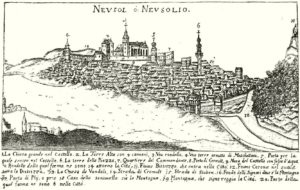Besztercebánya

Why were the cities of the Mining Town District so famous? No wonder, there were the richest gold, copper, and silver mines in the Kingdom of Hungary. Take a look at these nice pictures of one of these towns, Besztercebánya. At the same time, you can learn about the legend how a young Hungarian nobleman stole the secret of dividing copper from gold, guarded by the Venetians if you read it in my book “33 Castles, Battles, Legends”: https://www.amazon.com/dp/B077PTXF74

Besztercebánya, Neusohl or Banská Bystrica, the famous mining town of the Hungarian Kingdom, is located in the Upper lands/Horná Zem/Felvidék, it is in Slovakia. Enjoy the video, too: https://www.youtube.com/watch?v=iUVfoRUN3Kw

The town is 208 kilometers north-east of Pozsony (Bratislava, Pressburg) and 217 kilometers west of Kassa (Košice, Kaschau). It was perhaps the most famous and important copper mining town of the Carpathian Basin. The town acquired its present picturesque look in the Late Middle Ages when the prosperous burghers built its central churches, mansions, and fortifications.

The settlement was founded by German settlers in the 12th century. It was first destroyed by the Mongols in 1241 but soon King Béla IV had a new colony of German miners settled there from Thuringia and he made it a town in 1255. The town prospered because of the abundant copper ore in its mines.

The copper business began to thrive when Count Thurzó Elek and his descendants were in charge of the city. They gained their enormous wealth from the mining towns of the Upper Lands of Hungary. The Thurzós’ success was multiplied when they intermarried with the Fugger banker family. The affluent Fugger and Thurzo families founded the prosperous Ungarischer Handel company (German for “Hungarian Trade”) in 1494 which eventually became a leading world producer of copper by the 16th century. With the most sophisticated mining technologies in Europe, an advanced accounting system, and benefits including medical care for its 1,000 employees, Ungarischer Handel was one of the largest and most modern early-capitalist firms.
The Fuggers leased many more Hungarian mines and they traded precious metals all over Europe. They were the makers of kings, popes, and emperors in the continent and the mines of the Carpathian Mountains produced an immense profit for them. They were also involved in the selling of gray cattle herds to feed Germany but later they decided to invest their money into the slave trade in North America.

An early record of the miners’ industrial action in Besztercebánya is from 1526 when the City Council needed to take refuge within the confines of City Castle. Before the Battle of Mohács in 1526, the Fuggers gained 80% of the mining profit, 10% went to the Thurzó family and 10% arrived in the treasury of the king if the Vice-Treasurer failed to steal it. When King Louis II deprived them of the mining rights in 1525, the Fuggers removed all the mining equipment from the mines of Besztercebánya as well as from the other mines. They even withdrew all the professional local miners so that the king could not raise funds for his wars against the Ottoman invasion. Nobody was allowed to mess with the Fuggers without punishment.

During the Dual Kingship, King Habsburg Ferdinand took control of the mining cities, the Fuggers`men returned to Besztercebánya, and copper production was resumed. Let us not forget, that Emperor Charles V, the brother of Habsburg Ferdinand was in great debt to the Fuggers because the Fuggers had bought him his imperial title. The town was prospering, its famous clock tower was built in 1552 in its main square. It is a leaning tower and the top is 40 centimeters off the perpendicular like the famous leaning tower of Pisa, Italy.

Most of the buildings enclosing the square and those in the nearby streets are well-preserved Gothic, Renaissance, and Baroque noblemen’s mansions and wealthy burghers’ residences. The most interesting among them are the Benicky House and the Thurzó House, the latter hosting a museum with a regional archaeological collection and remarkable Gothic frescos.

The City has an inner castle that consists of a barbican protecting the main gate, three bastions, and part of the walls. There are two wonderful churches and the Matthias House, built in 1479 as a five-story late-Gothic structure with a Gothic portal and stone console balcony. It served as a temporary residence of King Matthias Corvinus and his Queen Beatrix. The Renaissance Old Town Hall, dating from 1500, has been transformed into an art museum. Besztercebánya was one of the richest towns in the Mining Towns District and it is no wonder that the Ottomans had been yearning for it. The Magistrate had the town fortified in 1589 but the Turks could never get close to its walls. The first Hungarian Diet was held in this fortified city, after the taking of Buda in 1541. Later in 1620, it was the city where the Diet elected Prince Bethlen Gábor to be King of Hungary.

The troops of Prince Thököly Imre took the town in 1678 and in 1680. The copper mines around the town were rented by the Fugger family throughout the period. The city was renowned for its rich gold, silver, mercury, and lead mines as well. Prince Ferenc II Rákóczi took it in 1703 and turned it into the industrial center of his War of Independence.

Dear Readers, I can only make this content available through small donations or by selling my books or T-shirts:
Please, feel free to support me with a coffee here:
You can check out my books "33 Castles, Battles, Legends" and "The Ring of Kékkő Castle" on Amazon or Draft2Digital, they are available in hardcover, paperback, or ebook: https://www.amazon.com/dp/198020490X or at https://books2read.com/b/boYd81
 My work can also be followed and supported on Patreon: Become a Patron!http://Become a Patron!
My work can also be followed and supported on Patreon: Become a Patron!http://Become a Patron!


https://hungarianottomanwars.myspreadshop.com/all

Here are more pictures of Besztercebánya:






























